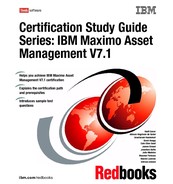16 Certification Study Guide Series: IBM Maximo Asset Management V7.1 2.2 Rotating item To understand rotating items, you have to understand the characteristics of assets and inventory items. An asset is something you want to assign work against ( work orders) or perform preventive maintenance on. Inventory items are for things you have to keep track of, the remaining balance, but are not normally used in work orders or do not require preventive maintenance. Rotating items have common characteristics from both. A good example is a pump. You have to keep track of the stock levels of a pump, but also have to assign work against it or perform preventive maintenance on it. So, pump is normally defined as a rotating item. Rotating assets have a unique asset number and an inventory item number. The item number lets you track assets as a group as they are moved in and out of inventory and other types of locations; and the asset number is useful to track individual instances of the asset as it is moved from one location to another and from one site to another. A rotating item has additional features to help you track whether it is ready to be used in a way that you specify. The intention of this is to specify assets that can be repaired rather than replaced. In this case, you can have very similar items that share the same model and manufacturer, same assembly structure, but with different life- to- date and maintenance history. A rotating item can be used in different places and locations or even as subassemblies for different assets. You can use it when you want to track an asset as it is moved from a location ( such as operating) or when you want to apply an Item Assembly Structure to that asset. When working with rotating items, you can add an item number, a current balance ( other than zero), and its instances to allow it to be used in different locations in a plant. For example, you might track all your trucks individually with the single item identifier Class 6 Truck. To associate an asset with a rotating item, use the Rotating Item field, as shown in Figure 2- 5 on page 17. Note: Assembly structures are individual parts and subassemblies that you build for an item. You use them on rotating items or you can apply them as a template for new rotating assets and new locations.
Chapter 2. Assets 17 Figure 2- 5 Rotating Item Field on Assets application A rotating item can also be associated with a location, which is very important because only assets and locations can be associated with a rotating item. When associated with a location, an item with a generic number can also have a balance number ( must be greater than one) and multiple instances of which can be used in different locations in the same site. To create a rotating item, you must add a valid rotating item from the Item Master application, as shown Figure 2- 6 on page 18.
18 Certification Study Guide Series: IBM Maximo Asset Management V7.1 Figure 2- 6 Main fields from Item Master application What converts an asset to a rotating item is its association with a valid item from the Item Master application. To create a valid item master, you must create a record with status of Active and with the Rotating? field check box selected. Then, you may add this Item to your asset record, which results in your asset being configured as a rotating item. When you move an asset for another location for repairs, you have limited types of locations that you can work with. Actually, when working with a non- rotating item, you may move this asset only for locations of type: Operating, Repair, Salvage, or Vendor. When working with a rotating item, this restriction is not applied anymore. For a rotating item, you may use items ( from the Item Master application) or tools ( from the Tools application). You may not use service items, because service itself is not a unique and consumable material. After you create a rotating item, the field Rotating Item becomes read- only. However, you may change it by using the Select Action menu and then selecting Change Item Number. The Change Item Number dialog opens, as shown in Figure 2- 7 on page 19.
Chapter 2. Assets 19 Figure 2- 7 Change Item Number All rotating item records can also have a rotating item number to track the asset as it moves from a storeroom to another asset or location, or to a repair facility site. Having both an asset and item number allows you to track those assets individually, with their unique asset numbers, and also as a group, with their shared item number. Figure 2- 8 shows the Rotating Item field in the Locations application. Figure 2- 8 Rotating Item field on Locations application
